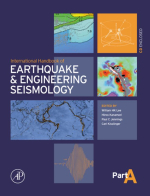Добрый день, Коллеги. Важное сообщение, просьба принять участие. Музей Ферсмана ищет помощь для реставрационных работ в помещении. Подробности по ссылке
International handbook earthquake and engineering seismology. Part A / Международный справочник по землетрясениям и инженерной сейсмологии. Часть А
Seismology is, in the truest sense of the word, a global science, not limited to political boundaries. Thus, it can only be effectively practiced through international cooperation.
Seismology is primarily an observational science. Quantitative measurements of seismic ground motion as a function of time require physically well defined, continuously recording instruments. Suitable seismographs of different design principles became available at the end of the 19th century. In the following years, a considerable number of seismograph stations were installed at sites around the globe. At the dawn of this century, some of these stations celebrate their 100th anniversary, as does the International Association of Seismology and Physics of the Earth’s Interior (IASPEI).
When it became evident that seismic signals propagate through the Earth over large distances, the need for an international organization to coordinate, collect and distribute the data, and promote earthquake research arose. During two “International Conferences on Seismology”, in 1901 and 1903 in Strasbourg, the establishment of an “International Association of Seismology” (IAS) was proposed. The association was inaugurated in 1904 and signed by 18 nations. This can be considered the root of what finally became the “International Association of Seismology and Physics of the Earth’s Interior’’.
So it is appropriate to state that the present Handbook reflects and encompasses one hundred years of a very dynamical and successful history of scientific seismology. Of course it has been a long and rocky path with changes and interruptions, mainly caused by the international political scene during and after the two World Wars. In 1919, the International Union of Geodesy and Geophysics (IUGG) was created with the “Seismological Section’’ as one of the founding components. In 1933, the name was changed to “International Association of Seismology” of the IUGG. With the expansion of its scope to include material properties of the Earth’s interior, it was renamed in 1951 to “International Association of Seismology and Physics of the Earth’s Interior’’, as it is known today.
Along with the progress in instrumentation, the theoretical basis of wave propagation in the Earth was being developed for the evaluation and interpretation of the observed traveltime data. By the end of the 1930s, a rough and still valid first model of the structure of a spherically symmetric Earth existed. This is equivalent to a static picture of the Earth.
While in the first half of the 20th century scientific seismology developed mainly in Europe and Japan, after World War II, the center of research activity shifted to the USA.
A mighty impetus came with the installation of the first true worldwide network of homogeneous seismograph stations (WWSSN) by the US government. Originally justified for fundamental research in support of the search for means to detect and identify underground nuclear explosions, it turned out to be a powerful tool for a very fruitful period of basic scientific research on a wide range of problems in the science of the Earth. <...>




